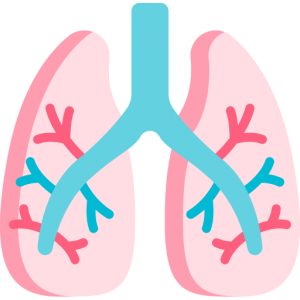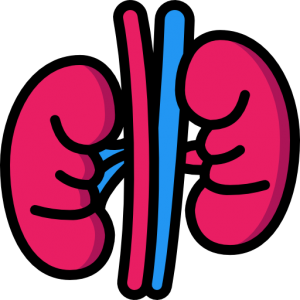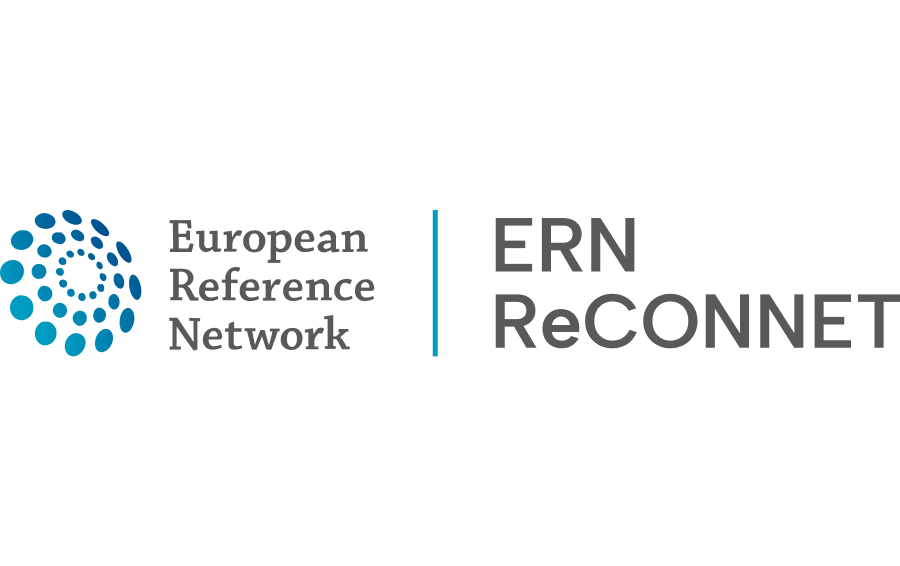ERN ReCONNET
Lay Versions
Disease: Systemic Sclerosis
Systemic Sclerosis Lay Versions
 “Scleroderma”, also known as Systemic Sclerosis (SSc), is a rare connective tissue disease. The immune system attacks the body’s own tissues (=autoimmunity) affecting the entire body including the skin and the internal organs (heart, lungs, kidneys, the gastrointestinal system as well as blood vessels).
“Scleroderma”, also known as Systemic Sclerosis (SSc), is a rare connective tissue disease. The immune system attacks the body’s own tissues (=autoimmunity) affecting the entire body including the skin and the internal organs (heart, lungs, kidneys, the gastrointestinal system as well as blood vessels).
Since 2017, the European Reference Network on Rare and Complex Connective Tissue and Musculoskeletal Diseases (ERN ReCONNET) is working to improve the management of SSc and to facilitate access to better, safer and more standardized healthcare for patients.
The ERN ReCONNET is a European Network composed of clinicians, researchers and patients’ representatives that work together to improve the care of patients affected by rare and complex connective tissue diseases. Patients’ representatives (ePAGs) bring within the ERNs the unmet needs of their communities and the experience of living with the disease. Their training and knowledge allow them to evaluate and design, together with clinicians, all the necessary actions to achieve a better care for patients suffering from rare and complex diseases. Within ERN ReCONNET, 7 ePAG Representatives are working to give voice to rare and complex connective tissue and musculoskeletal diseases. One of the 7 ePAG Representatives is working for Systemic Sclerosis.
The ERN ReCONNET is working on many topics, including the Clinical Practice Guidelines (CPGs). CPGs are statements that advise clinicians about appropriate patient care. They are based on evidence and carefully take into account the benefits and harms of alternative options of care. CPGs also aim at harmonising the delivery of high-quality healthcare. In this work we present the results of one of the activities of the ERN ReCONNET that was performed thanks to a collaboration among ePAGs and experts in SSc. This work was dedicated to the identification and evaluation of existing CPGs on the management (diagnosis, monitoring and treatment) of SSc patients.
The ERN ReCONNET SSc group, composed of clinicians and ePAGs, have searched in the scientific literature and have identified 893 articles, including 28 CPGs. Unfortunately, guidelines taking into consideration the patient’s perspective were not found, even if they are highly needed.
Below you can find a summary of the CPGs that were identified, starting from the diagnosis – which is crucial for a better management of the disease – to the unmet needs, that could address future steps of clinicians and patient representatives. The CPGs cover different topics; we decided to group them in different domains, to collect them in an organic way and to make them easier to consult. For example, the CPGs concerning the procedures leading to the healing or to the cure of the disease, will be in the section Treatment. For each topic, a list of the existing publications is available at the end of the section.
List of references
- Smith V, Scirè CA, Talarico R, et al. Systemic sclerosis: state of the art on clinical practice guidelines. RMD Open 2019;4:e000782. doi: 10.1136/rmdopen-2018-000782. FREE TO VIEW
- Talarico R, Marinello D, Bombardieri S, et al. Clinical practice guidelines adherence, knowledge and awareness in rare and complex connective tissue diseases across Europe: results from the first ERN ReCONNET survey. RMD Open 2020;6:e001344. doi: 10.1136/rmdopen-2020-001344. FREE TO VIEW
- ERN ReCONNET webinar “Clinical practice guidelines: what do you need to know”
 One guideline informs about clinical manifestations and classification criteria; procedures to diagnose SSc, through capillaroscopy and serum antibodies; possible involved organs and their diagnostic work-up; therapeutic options for each SSc related organ manifestation. However, even if not retained as clinical practice guidelines, criteria can guide doctors in the very early and early diagnosis of SSc and in the classification.
One guideline informs about clinical manifestations and classification criteria; procedures to diagnose SSc, through capillaroscopy and serum antibodies; possible involved organs and their diagnostic work-up; therapeutic options for each SSc related organ manifestation. However, even if not retained as clinical practice guidelines, criteria can guide doctors in the very early and early diagnosis of SSc and in the classification.
List of references
- van den Hoogen F, Khanna D, Fransen J, Johnson SR, Baron M, Tyndall A, et al. 2013 classification criteria for systemic sclerosis: an American college of rheumatology/European league against rheumatism collaborative initiative. Ann Rheum Dis. 2013;72(11):1747-55. FREE TO VIEW
- Avouac J, Fransen J, Walker UA, Riccieri V, Smith V, Muller C, et al. Preliminary criteria for the very early diagnosis of systemic sclerosis: results of a Delphi Consensus Study from EULAR Scleroderma Trials and Research Group. Annals of the rheumatic diseases. 2011;70(3):476-81. FREE TO VIEW
- Koenig M, Joyal F, Fritzler MJ, Roussin A, Abrahamowicz M, Boire G, et al. Autoantibodies and microvascular damage are independent predictive factors for the progression of Raynaud’s phenomenon to systemic sclerosis: a twenty-year prospective study of 586 patients, with validation of proposed criteria for early systemic sclerosis. Arthritis Rheum 2008;58(12):3902–12. FREE TO VIEW
- LeRoy EC, Medsger Jr. TA. Criteria for the classification of early systemic sclerosis. J Rheumatol 2001;28(7):1573–6. FREE TO VIEW
 CPGs give recommendations for the treatment of different SSc-related organ manifestations. Some of them focus on the medicinal treatment of SSc-related Raynaud’s Phenomenon, digital ulcers, skin involvement, heart and lung problems, kidney involvement and digestive tract problems. Other guidelines additionally focus on heart failure, calcinosis and musculoskeletal problems. Moreover, they give advice on general measures and treatments without medicines.
CPGs give recommendations for the treatment of different SSc-related organ manifestations. Some of them focus on the medicinal treatment of SSc-related Raynaud’s Phenomenon, digital ulcers, skin involvement, heart and lung problems, kidney involvement and digestive tract problems. Other guidelines additionally focus on heart failure, calcinosis and musculoskeletal problems. Moreover, they give advice on general measures and treatments without medicines.
List of references
- Kowal-Bielecka O, Fransen J, Avouac J, Becker M, Kulak A, Allanore Y, et al. Update of EULAR recommendations for the treatment of systemic sclerosis. Ann Rheum Dis. 2017;76(8):1327-39. FREE TO VIEW
- Sampaio-Barros PD, Zimmermann AF, Muller Cde S, Borges CT, Freire EA, Maretti GB, et al. Recommendations for the management and treatment of systemic sclerosis. Rev Bras Reumatol. 2013;53(3):258-75. FREE TO VIEW
- Distler JH, Jordan S, Airo P, Alegre-Sancho JJ, Allanore Y, Balbir Gurman A, et al. Is there a role for TNFalpha antagonists in the treatment of SSc? EUSTAR expert consensus development using the Delphi technique. Clin Exp Rheumatol. 2011;29(2 Suppl 65):S40-5. FREE TO VIEW
- Knobler R, Berlin G, Calzavara-Pinton P, Greinix H, Jaksch P, Laroche L, et al. Guidelines on the use of extracorporeal photopheresis. J Eur Acad Dermatol Venereol. 2014;28 Suppl 1:1-37. FREE TO VIEW
 Raynaud’s Phenomenon, an uncommon response to cold exposure or an emotionally stressful situation, is typically the first sign of SSc, and involves the smallest blood vessels causing reduced blood flow to the extremities of the body.
Raynaud’s Phenomenon, an uncommon response to cold exposure or an emotionally stressful situation, is typically the first sign of SSc, and involves the smallest blood vessels causing reduced blood flow to the extremities of the body.
Three CPGs (of which one is specific for children) focus on the screening and diagnosis of SSc-related Raynaud’s Phenomenon; they recommend performing a thorough review of the patient’s clinical history, clinical examination, blood tests to search for the presence of autoantibodies (including SSc specific antibodies) and nailfold videocapillaroscopy (see figure 4) to find signs indicative of SSc-related Raynaud’s Phenomenon.
Digital ulcers (sometimes very painful) can occur spontaneously at the fingers and/or at the toes and are a severe sign of Raynaud’s Phenomenon. Due to the reduced or poor blood flow, digital ulcers are slow to heal and more prone to infections. If not treated, the underlying bone can become infected (i.e. osteomyelitis) or the involved skin tissue may die (i.e. gangrene).
One CPG proposes standard definitions to help medical doctors classify finger wounds as being active, indeterminate or healed.
List of references
- Baron M, Chung L, Gyger G, Hummers L, Khanna D, Mayes MD, et al. Consensus opinion of a North American Working Group regarding the classification of digital ulcers in systemic sclerosis. Clin Rheumatol. 2014;33(2):207-14.
- Fujimoto M, Asano Y, Ishii T, Ogawa F, Kawakami T, Kodera M, et al. The wound/burn guidelines – 4: Guidelines for the management of skin ulcers associated with connective tissue disease/vasculitis. J Dermatol. 2016;43(7):729-57. FREE TO VIEW
- Hughes M, Ong VH, Anderson ME, Hall F, Moinzadeh P, Griffiths B, et al. Consensus best practice pathway of the UK Scleroderma Study Group: digital vasculopathy in systemic sclerosis. Rheumatology (Oxford). 2015;54(11):2015-24. FREE TO VIEW
- Pistorius MA, Carpentier PH, le groupe de travail «Microcirculation» de la Société française de médecine vasculaire. [Minimal work-up for Raynaud syndrome: a consensus report. Microcirculation Working Group of the French Vascular Medicine Society]. J Mal Vasc. 2012;37(4):207-12.
- Maverakis E, Patel F, Kronenberg DG, Chung L, Fiorentino D, Allanore Y, et al. International consensus criteria for the diagnosis of Raynaud’s phenomenon. J Autoimmun. 2014;48-49:60-5.
- Cutolo M, Smith V, Furst DE, Khanna D, Herrick AL. Points to consider-Raynaud’s phenomenon in systemic sclerosis. Rheumatology (Oxford). 2017;56(suppl_5):v45-v8. FREE TO VIEW
- Smith V, Herrick AL, Ingegnoli F, Damjanov N, De Angelis R, Denton CP, et al. Standardisation of nailfold capillaroscopy for the assessment of patients with Raynaud’s phenomenon and systemic sclerosis. Autoimmun Rev. 2020:102458. FREE TO VIEW
- Smith V, Vanhaecke A, Herrick AL, Distler O, Guerra MG, Denton CP, et al. Fast track algorithm: How to differentiate a “scleroderma pattern” from a “non-scleroderma pattern”. Autoimmun Rev. 2019;18(11):102394. FREE TO VIEW
 Fibrotic tissue can appear in the different organs of the digestive system: mouth, oesophagus, stomach and the intestines, reducing their ability to work properly. Up to 90% of people with SSc experience problems with their digestive system.
Fibrotic tissue can appear in the different organs of the digestive system: mouth, oesophagus, stomach and the intestines, reducing their ability to work properly. Up to 90% of people with SSc experience problems with their digestive system.
The following problems might appear due to oral involvement: dry mouth, difficulty swallowing, limited mouth opening. One GPG gives recommendations on the preventive and curative treatment of oral and dental complications.
Other gastro-intestinal problems are reflux, vomiting, abdominal pain and distension, weight loss and nutritional problems (such as malnutrition), diarrhoea, incontinence and constipation. One CPG proposes a technical calculation to guide medical doctors in the diagnosis and treatment of gastro-intestinal manifestations. Another one provides a practical approach to manage malnutrition, including:
- screening and evaluation of malnutrition based on their clinical history, physical examination, questionnaires, blood tests and breath tests;
- interventions to diagnose and to pharmacologically (and non-pharmacologically) treat patients in whom malnutrition is expected; and
- how to evaluate and follow-up malnutrition in SSc patients.
List of references
- Alantar A, Cabane J, Hachulla E, Princ G, Ginisty D, Hassin M, et al. Recommendations for the care of oral involvement in patients with systemic sclerosis. Arthritis Care Res (Hoboken). 2011;63(8):1126-33. FREE TO VIEW
- Baron M, Bernier P, Cote LF, Delegge MH, Falovitch G, Friedman G, et al. Screening and therapy for malnutrition and related gastro-intestinal disorders in systemic sclerosis: recommendations of a North American expert panel. Clin Exp Rheumatol. 2010;28(2 Suppl 58):S42-6. FREE TO VIEW
- Hansi N, Thoua N, Carulli M, Chakravarty K, Lal S, Smyth A, et al. Consensus best practice pathway of the UK scleroderma study group: gastrointestinal manifestations of systemic sclerosis. Clin Exp Rheumatol. 2014;32(6 Suppl 86):S-214-21.
 The lungs can be seriously involved in SSc patients. In interstitial lung disease, normal lung tissue becomes fibrotic and breathing becomes difficult. Very recently, one guideline has been published on the identification and management of this complication. It suggests to perform a high-resolution computed tomography at baseline in all SSc patients to identify the presence of interstitial lung disease and to regularly perform pulmonary function tests both as a screening method and for the monitoring of progression. Of note, this guideline states that the treatment should depend on the severity of the disease (which can be seen on high-resolution computed tomography).
The lungs can be seriously involved in SSc patients. In interstitial lung disease, normal lung tissue becomes fibrotic and breathing becomes difficult. Very recently, one guideline has been published on the identification and management of this complication. It suggests to perform a high-resolution computed tomography at baseline in all SSc patients to identify the presence of interstitial lung disease and to regularly perform pulmonary function tests both as a screening method and for the monitoring of progression. Of note, this guideline states that the treatment should depend on the severity of the disease (which can be seen on high-resolution computed tomography).
Another complication is the pulmonary arterial hypertension, the rise in the blood pressure of the pulmonary artery (the big blood vessel that transports the blood to the lungs). Pulmonary arterial hypertension can cause the heart to overload as it needs to pump harder to push the blood through the blood vessels. As a result, the pumping function of the heart can be insufficient (heart failure), can beat too fast (tachycardia) or too slow (bradycardia). In some cases, inflammation of the tissues around the heart (pericarditis) or of the heart muscle (myocarditis) can occur.
Three guidelines were found on the management of this complication. Two of them recommend to perform ultrasound of the heart (echocardiography) as a screening test in patients with no symptoms, followed by yearly echocardiography, lung function and blood tests. Other guidelines give recommendations about how and when to perform an examination (catheterisation) to make a diagnosis of pulmonary arterial hypertension in patients affected by systemic sclerosis.
One guideline suggests a practical approach to manage heart involvement.
Three major steps are outlined:
- identification of warning signs;
- investigation of the risk to develop heart involvement;
- treatment of heart disease with medication or implantation of devices.
Another guideline gives recommendations on when and how to use cardiac magnetic resonance imaging to diagnose heart diseases.
List of references
- Hoffmann-Vold A-M, Maher TM, Philpot EE, Ashrafzadeh A, Barake R, Barsotti S, et al. The identification and management of interstitial lung disease in systemic sclerosis: evidence-based European consensus statements. Lancet Rheumatol. 2020;2:e71-83.
- Avouac J, Huscher D, Furst DE, Opitz CF, Distler O, Allanore Y, et al. Expert consensus for performing right heart catheterisation for suspected pulmonary arterial hypertension in systemic sclerosis: a Delphi consensus study with cluster analysis. Ann Rheum Dis. 2014;73(1):191-7.
- Bissell LA, Anderson M, Burgess M, Chakravarty K, Coghlan G, Dumitru RB, et al. Consensus best practice pathway of the UK Systemic Sclerosis Study group: management of cardiac disease in systemic sclerosis. Rheumatology (Oxford). 2017;56(6):912-21. FREE TO VIEW
- Mavrogeni SI, Kitas GD, Dimitroulas T, Sfikakis PP, Seo P, Gabriel S, et al. Cardiovascular magnetic resonance in rheumatology: Current status and recommendations for use. Int J Cardiol. 2016;217:135-48.
 Kidneys involvement may lead to an acute loss of their function. This acute deterioration is called scleroderma renal crisis, and a first sign is the sudden increase of the systolic blood pressure (the first number) or the occurrence of severe hypertension (i.e. blood pressure higher than 150/85 mmHg).
Kidneys involvement may lead to an acute loss of their function. This acute deterioration is called scleroderma renal crisis, and a first sign is the sudden increase of the systolic blood pressure (the first number) or the occurrence of severe hypertension (i.e. blood pressure higher than 150/85 mmHg).
One CPG highlights the early identification, diagnosis and prompt treatment of scleroderma renal crisis, recommending twice weekly blood pressure monitoring at home as a screening test in all SSc patients with diffuse skin involvement in the first 4 years of diagnosis. A combination of sudden onset hypertension, blood test and findings in urine tests pointing to kidney serious involvement and the results of kidney biopsy might result in a diagnosis of scleroderma renal crisis. An acute treatment with blood pressure control in highly experienced centres is recommended.
List of references
- Lynch BM, Stern EP, Ong V, Harber M, Burns A, Denton CP. UK Scleroderma Study Group (UKSSG) guidelines on the diagnosis and management of scleroderma renal crisis. Clin Exp Rheumatol. 2016;34 Suppl 100(5):106-9.
 Highly specialized treatment possibilities have been advised in separate CPGs. Three of them regard the use of haematopoietic stem cell transplantation (HSCT). One recommends that HSCT should be considered as an alternative therapy for SSc, especially regarding lung involvement, in patients without severe heart or gastro-intestinal involvement. Moreover, a guideline states that “HSCT should be considered for the treatment of selected patients with rapidly progressive SSc at risk of organ failure”. Two CPGs have been published to reduce the possible toxic side-effect of HSCT on the heart muscle and its high risk of early treatment-related mortality. The most recent guideline additionally recommends investigating the lungs and digestive system. This recommendation applies to patients under 65 years of age, with a disease duration of less than 5 years and who have fast evolving diffuse skin involvement with no symptoms of pulmonary arterial hypertension.
Highly specialized treatment possibilities have been advised in separate CPGs. Three of them regard the use of haematopoietic stem cell transplantation (HSCT). One recommends that HSCT should be considered as an alternative therapy for SSc, especially regarding lung involvement, in patients without severe heart or gastro-intestinal involvement. Moreover, a guideline states that “HSCT should be considered for the treatment of selected patients with rapidly progressive SSc at risk of organ failure”. Two CPGs have been published to reduce the possible toxic side-effect of HSCT on the heart muscle and its high risk of early treatment-related mortality. The most recent guideline additionally recommends investigating the lungs and digestive system. This recommendation applies to patients under 65 years of age, with a disease duration of less than 5 years and who have fast evolving diffuse skin involvement with no symptoms of pulmonary arterial hypertension.
List of references
- Rodrigues MC, Hamerschlak N, de Moraes DA, Simoes BP, Rodrigues M, Ribeiro AA, et al. Guidelines of the Brazilian society of bone Marrow transplantation on hematopoietic stem cell transplantation as a treatment for the autoimmune diseases systemic sclerosis and multiple sclerosis. Rev Bras Hematol Hemoter. 2013;35(2):134-43. FREE TO VIEW
- Saccardi R, Tyndall A, Coghlan G, Denton C, Edan G, Emdin M, et al. Consensus statement concerning cardiotoxicity occurring during haematopoietic stem cell transplantation in the treatment of autoimmune diseases, with special reference to systemic sclerosis and multiple sclerosis. Bone Marrow Transplant. 2004;34(10):877-81. FREE TO VIEW
- Farge D, Burt RK, Oliveira MC, Mousseaux E, Rovira M, Marjanovic Z, et al. Cardiopulmonary assessment of patients with systemic sclerosis for hematopoietic stem cell transplantation: recommendations from the European Society for Blood and Marrow Transplantation Autoimmune Diseases Working Party and collaborating partners. Bone Marrow Transplant. 2017;52(11):1495-503. FREE TO VIEW
 Some SSc patients have a higher risk to develop cancers, especially those with a particular type of SSc-specific (serum) (auto-) antibodies (i.e. anti-RNA polymerase III antibodies).
Some SSc patients have a higher risk to develop cancers, especially those with a particular type of SSc-specific (serum) (auto-) antibodies (i.e. anti-RNA polymerase III antibodies).
One guideline suggests to screen for cancers at the time of diagnosis of SSc with a special focus on breast cancer. Cancer tests should preferably be performed using non-invasive tools with the lowest possible dose of radiation such as mammography, ultrasonography, magnetic resonance imaging, occurrence of blood in stool samples, blood tests or positron emission tomography scan. Regular tests for cancer are recommended in the first 2 to 5 years of SSc diagnosis with anti-RNA polymerase III antibody positivity.
List of references
- Lazzaroni MG, Cavazzana I, Colombo E, Dobrota R, Hernandez J, Hesselstrand R, et al. Malignancies in Patients with Anti-RNA Polymerase III Antibodies and Systemic Sclerosis: Analysis of the EULAR Scleroderma Trials and Research Cohort and Possible Recommendations for Screening. J Rheumatol. 2017;44(5):639-47. FREE TO VIEW
 Clinical trials are scientific studies or experiments that investigate new methods to screen, diagnose, treat or prevent diseases.
Clinical trials are scientific studies or experiments that investigate new methods to screen, diagnose, treat or prevent diseases.
At the time of analysis, three CPGs give recommendations on the design of future clinical trials in SSc, one focusing on future clinical trials in SSc patients in general, the other in patients with lung disease and the third one in patients with Raynaud’s Phenomenon.
Of note, recently, eight guidelines have been published that advise how to set up clinical trials investigating the following topics in SSc patients: quality of life, joint inflammation, digestive tract problems, heart and lung problems, musculoskeletal involvement, finger wounds and kidney involvement.
List of references
- Khanna D, Furst DE, Allanore Y, Bae S, Bodukam V, Clements PJ, et al. Twenty-two points to consider for clinical trials in systemic sclerosis, based on EULAR standards. Rheumatology (Oxford). 2015;54(1):144-51. FREE TO VIEW
- Khanna D, Brown KK, Clements PJ, Elashoff R, Furst DE, Goldin J, et al. Systemic sclerosis-associated interstitial lung disease-proposed recommendations for future randomized clinical trials. Clin Exp Rheumatol. 2010;28(2 Suppl 58):S55-62. FREE TO VIEW
 This is the first manuscript that identifies, evaluates and summarizes existing CPGs for the management (diagnosis, monitoring and treatment) of SSc patients. Moreover, it is the first manuscript that identifies gaps in the management of SSc patients from both patients’ and doctors’ perspective.
This is the first manuscript that identifies, evaluates and summarizes existing CPGs for the management (diagnosis, monitoring and treatment) of SSc patients. Moreover, it is the first manuscript that identifies gaps in the management of SSc patients from both patients’ and doctors’ perspective.
1. Gaps in the management of SSc patients from the patients’ perspective
Ilaria Galetti, the patient representative who represents the voice of the European SSc patients, collected from the European community, points out gaps in the management of SSc patients from the patients’ perspective.
The name of the disease creates uncertainty among SSc patients, as “sclerosis” can be confused with multiple sclerosis and as systemic sclerosis and scleroderma are often interchangeably used in literature. Another uncertainty for SSc patients exists due to a lack of harmonization of treatment amongst healthcare providers and amongst different treatment centres (e.g. patients from different places receive different therapeutic procedures, dosages or treatment duration). Moreover, do health care systems not always provide a reimbursement for some crucial and fundamental therapies (e.g. psychotherapy and physiotherapy). Of note do patients experience a limited access to uniform information as there are only a limited number of trained professionals who are fully aware of the currently existing guidelines.
Some disease related manifestations, such as loss of physical mobility and hand function as well as pain, imply a heavy burden and can make patients feel lonely in carrying their disease. This can lead to a major deterioration of the health-related quality of life of SSc patients. At present, no clinical practice guidelines exist that advise on how to improve the health-related quality of life of SSc patients using non-medicinal treatment (e.g. psychological, educational or physical therapy). The “Scleroderma Patient centred Intervention Network”, an organisation of researchers, health care providers and people living with SSc from around the world, was established to address this need.
Another important gap is the fact that SSc patients are not included in the development of the patient reported outcome measures for clinical trials in SSc. These are health outcomes directly reported by the patient who experienced them and they are useful to provide a better understanding of the condition from a patient’s perspective.
Last but not least, SSc patients experience that the impact of their disease on their daily life (loss of self-esteem due to facial changes, fatigue, sexual dysfunction, job related problems, feeding and relational problems) is underestimated in the global population, due to a lack of knowledge of the disease.
2. Gaps in the management of SSc patients from doctors’ perspectiv
Finally, the ERN ReCONNET SSc scientific team (Marco Matucci-Cerinic and Vanessa Smith) summarized gaps in the management of SSc patients from doctors’ perspective.
High quality CPGs that focus on the entire management of each possible SSc-related organ involvement or damage are lacking. This could provide access to uniform management of SSc patients on a national and/or international level.
Although some research projects are being performed (i.e. development of criteria to assess the scleroderma renal crisis or a standardized definition for finger wounds), yet the ideal use of high-resolution computed tomography in SSc patients and the role of steroids in SSc patients still need to be explored. In addition, although there are criteria in literature, no clinical practice guidelines exist for the very early and early diagnosis of SSc, nor to definitely diagnose SSc. Their existence, however, would ensure an early referral to tertiary centres and a better management.
It should also be noted that nailfold videocapillaroscopy is an important tool to early detect those patients with Raynaud’s Phenomenon who will develop SSc. As such, the performance and interpretation of nailfold videocapillaroscopy need to be standardized. Of note it should be interesting to standardise SSc-specific investigational techniques (e.g. antibody assays for SSc-specific antibodies). This may further help to definitively reach an agreement on the standardized evaluation of SSc patients.
List of references
- Hoa S, Stern EP, Denton CP, Hudson M, Scleroderma Clinical Trials Consortium Scleroderma Renal Crisis Working Group Investigators of the Scleroderma Clinical Trials Consortium Scleroderma Renal Crisis Working G. Towards developing criteria for scleroderma renal crisis: A scoping review. Autoimmunity reviews. 2017;16(4):407-15.
- Suliman YA, Bruni C, Johnson SR, Praino E, Alemam M, Borazan N, et al. Defining Skin Ulcers in Systemic Sclerosis: Systematic Literature Review and Proposed World Scleroderma Foundation (WSF) Definition. Journal of Scleroderma and Related Disorders. 2018;2(2):115-20.
- Sullivan KM, Goldmuntz EA, Keyes-Elstein L, McSweeney PA, Pinckney A, Welch B, et al. Myeloablative Autologous Stem-Cell Transplantation for Severe Scleroderma. The New England journal of medicine. 2018;378(1):35-47.
- Herrick AL. Controversies on the use of steroids in systemic sclerosis. Journal of Scleroderma and Related Disorders. 2017;2(2):84-91.
- Cutolo M, Sulli A, Pizzorni C, Accardo S. Nailfold videocapillaroscopy assessment of microvascular damage in systemic sclerosis. The Journal of rheumatology. 2000;27(1):155-60.
- Smith V, Beeckman S, Herrick AL, Decuman S, Deschepper E, De Keyser F, et al. An EULAR study group pilot study on reliability of simple capillaroscopic definitions to describe capillary morphology in rheumatic diseases. Rheumatology (Oxford, England). 2016;55(5):883-90.
- Cutolo M, Melsens K, Herrick AL, Foeldvari I, Deschepper E, De Keyser F, et al. Reliability of simple capillaroscopic definitions in describing capillary morphology in rheumatic diseases. Rheumatology (Oxford, England). 2018;57(4):757-9.
- Milette K, Thombs BD, Maiorino K, Nielson WR, Korner A, Pelaez S. Challenges and strategies for coping with scleroderma: implications for a scleroderma-specific self-management program. Disability and rehabilitation. 2018:1-10.
- Lopez-Bastida J, Linertova R, Oliva-Moreno J, Serrano-Aguilar P, Posada-de-la-Paz M, Kanavos P, et al. Social/economic costs and health-related quality of life in patients with scleroderma in Europe. The European journal of health economics : HEPAC : health economics in prevention and care. 2016;17 Suppl 1:109-17.
- Bassel M, Hudson M, Taillefer SS, Schieir O, Baron M, Thombs BD. Frequency and impact of symptoms experienced by patients with systemic sclerosis: results from a Canadian National Survey. Rheumatology (Oxford, England). 2011;50(4):762-7.
- Thombs BD, Jewett LR, Assassi S, Baron M, Bartlett SJ, Maia AC, et al. New directions for patient-centred care in scleroderma: the Scleroderma Patient-centred Intervention Network (SPIN). Clinical and experimental rheumatology. 2012;30(2 Suppl 71):S23-9.
- Pauling JD, Frech TM, Domsic RT, Hudson M. Patient participation in patient-reported outcome instrument development in systemic sclerosis. Clinical and experimental rheumatology. 2017;35 Suppl 106(4):184-92.
- Nakayama A, Tunnicliffe DJ, Thakkar V, Singh-Grewal D, O’Neill S, Craig JC, et al. Patients’ Perspectives and Experiences Living with Systemic Sclerosis: A Systematic Review and Thematic Synthesis of Qualitative Studies. The Journal of rheumatology. 2016;43(7):1363-75.
- Decuman S, Smith V, Verhaeghe S, Deschepper E, Vermeiren F, De Keyser F. Work participation and work transition in patients with systemic sclerosis: a cross-sectional study. Rheumatology (Oxford, England). 2012;51(2):297-304.



